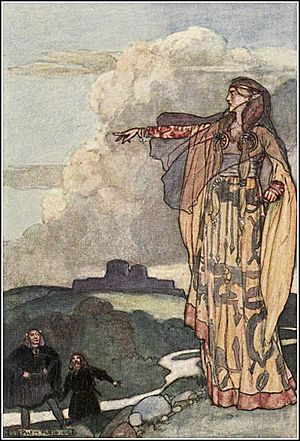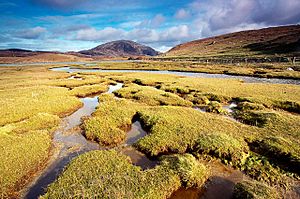Macha facts for kids
Macha was a powerful goddess in ancient Irish mythology. She was especially linked to the region of Ulster. Two important places, Navan Fort (Eamhain Mhacha) and Armagh (Ard Mhacha), are named after her.
Many stories in Irish myths and folklore feature characters called Macha. People believe they all come from the same main goddess. She is sometimes said to be one of three sisters known as 'the three Morrígna'. Like other goddesses of the land, Macha is connected to the earth, new life, kingship, war, and horses.
Historians often talk about different versions of Macha. These include Macha, wife of Nemed; Queen Macha, wife of Cimbáeth; and Macha, wife of Crunnchu, who caused a famous weakness among the men of Ulster. Another important Macha is Macha Mong Ruad.
Contents
What Does the Name Macha Mean?
The name Macha likely comes from an old Celtic word meaning "a plain" or "flat land." In modern Scottish Gaelic, a similar word, machair, describes a fertile, grassy plain. This land stays healthy because animals constantly walk and graze on it.
In old Irish texts called the Dindsenchas, Macha is called Grian Banchure. This means "Sun of Womanfolk." She is also said to be the daughter of Midir, a god from Brí Léith.
Macha, Daughter of Partholón
An old poem in the Lebor Gabála Éirinn (The Book of the Taking of Ireland) mentions Macha. It says she was one of the daughters of Partholón. He was the leader of the first group of people to settle in Ireland after a great flood. However, the poem does not share many details about her life.
Macha, Wife of Nemed
Other old stories tell of a second Macha. She was the wife of Nemed, who led the second group of settlers to Ireland after the flood. Macha was the very first person from Nemed's group to die in Ireland. Some stories say she died twelve years after they arrived. Others say it was just twelve days.
The hilltop where she was buried was named after her. It was called Ard Mhacha, which means "Macha's high place." Nemed's people also cleared the nearby forest. They named this new open land Magh Mhacha, or "Macha's plain." She is described as a powerful figure, like a "raven of the raids."
Macha, Daughter of Ernmas
Macha, daughter of Ernmas, was part of the Tuatha Dé Danann. These were a group of god-like people in Irish myth. She often appears with her sisters, Badb and Morrigu. These three are often seen as a triple goddess linked to war.
An old text from the 13th century describes Macha as "one of the three morrígna." It also says that Mesrad Machae, or "the mast of Macha," refers to "the heads of men who have been killed in battle." Another text says Macha is the same as Badb. It calls the three sisters "raven women" who start battles.
Some writers called them "goddesses." However, medieval Irish traditions tried to remove signs of old pagan religions. Macha is said to have been killed by the evil giant Balor during a battle against the Fomorians.
Macha Mong Ruad (Red Hair)
Macha Mong Ruad, meaning "red hair," was the daughter of Áed Rúad. According to old legends, she was the only queen to ever rule as High King of Ireland. Her father, Áed, used to share the kingship with his cousins, Díthorba and Cimbáeth. Each ruled for seven years at a time.
After Áed died, it was his turn to rule again. Macha stepped forward and claimed the kingship. Díthorba and Cimbáeth refused to let a woman be king. So, a battle began. Macha won, and Díthorba was killed. She then won a second battle against Díthorba's sons. They ran away into the wild lands of Connacht.
Macha chased Díthorba's sons by herself. She dressed up as a poor, sick woman. She caught each of them, tied them up, and carried all three back to Ulster. The men of Ulster wanted to kill them. But Macha decided to make them her slaves instead. She forced them to build Emain Macha (Navan Fort). This was to be the capital city of the Ulaid people. She marked out its borders with her special brooch. This is why the name Emain Macha is sometimes explained as "Macha's neck-brooch."
Macha ruled with Cimbáeth for seven years. After he died from a sickness, she ruled alone for another fourteen years. She was eventually killed by Rechtaid Rígderg. Her reign is thought to have been around 323–283 BC or 468–461 BC.
Historian Marie-Louise Sjoestedt wrote that this Macha shows a new side of the goddess. She is a powerful warrior and a ruler.
Macha, Wife of Cruinniuc
Another important Macha was the wife of Cruinniuc, a farmer from Ulster. After Cruinniuc's first wife died, Macha simply appeared at his house. Without saying a word, she started taking care of his home and acting as his wife. Soon, she became pregnant with his children. As long as they were together, Cruinniuc became very wealthy.
One day, Cruinniuc left to go to a festival organized by the king of Ulster. Macha warned him that she would only stay with him if he never spoke about her to anyone. He promised to keep her a secret. However, during a chariot race at the festival, Cruinniuc boasted. He claimed his wife could run faster than the king's horses.
The king was angry. He ordered Cruinniuc to be held. He said Cruinniuc would die unless he could prove his claim. Even though she was very pregnant, Macha was brought to the gathering. The king forced her to race against his horses. She won the race! But then she cried out in pain. She gave birth to twins right on the finish line: a boy named Fír ("True") and a girl named Fial ("Modest").
Because the king had disrespected and shamed her, Macha put a curse on the men of Ulster. She said they would be overcome with weakness, "as weak as a woman in childbirth," whenever they needed their strength the most. This weakness would last for five days and the curse would continue for nine generations. After this, the place where Macha gave birth was called Emain Macha, meaning "Macha's twins."
This story, called The Debility of the Ulstermen, explains the name Emain Macha. It also explains why only the great hero Cúchulainn could fight off an invasion of Ulster in the famous tale Táin Bó Cuailnge. This story shows that Macha, as a goddess of the land and its rule, can be very angry if she is disrespected. It also shows how a bad king's actions can lead to disaster.
This Macha is strongly linked to horses. It is interesting that twin colts were born on the same day as Cúchulainn. Also, one of Cúchulainn's chariot horses was named Liath Macha, or "Macha's Grey." She is often compared to Rhiannon, a similar figure in Welsh mythology.
See also
 In Spanish: Macha (mitología) para niños
In Spanish: Macha (mitología) para niños



